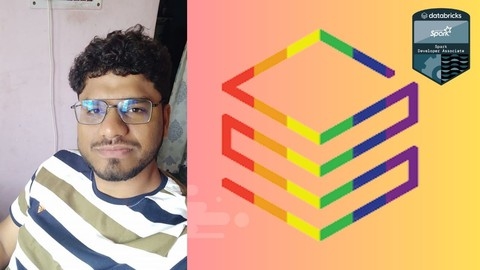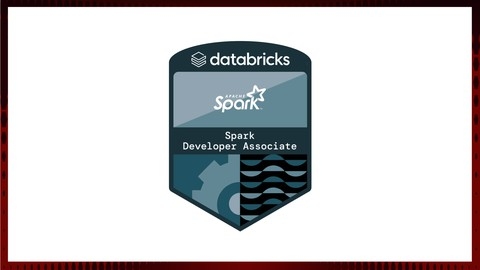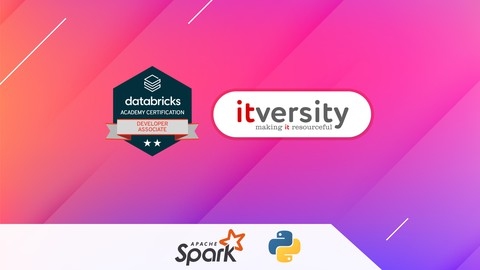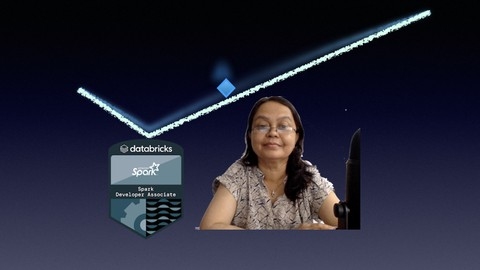Apache Spark is a powerful open-source framework for processing large datasets in a distributed fashion.
By learning Spark, you can unlock the potential to analyze massive amounts of data, build data pipelines, and develop machine learning models at scale.
This skillset is highly sought after, opening doors to lucrative careers in data science, data engineering, and big data analytics.
Finding the right Databricks Certified Associate Developer for Apache Spark prep course on Udemy can be a daunting task, given the abundance of options available.
You’re looking for a program that thoroughly prepares you for the certification exam, equips you with practical skills, and helps you build a solid understanding of the Spark ecosystem.
We’ve meticulously reviewed countless courses and have identified Apache Spark 3 - Databricks Certified Associate Developer as the best overall course on Udemy.
This program offers a comprehensive curriculum covering the essential concepts and practical techniques needed to excel as a Databricks Certified Associate Developer.
The course emphasizes hands-on learning, providing numerous coding exercises and projects to solidify your understanding.
While this is our top recommendation, there are other excellent courses available on Udemy.
Keep reading to discover more options that cater to different learning styles, specific areas of Spark expertise, and your unique career goals.
Apache Spark 3 - Databricks Certified Associate Developer
You’ll start by learning how Apache Spark runs on a cluster, understanding the architecture behind distributed processing.
The course guides you through creating clusters on both Azure Databricks and the Databricks Community Edition, so you can get a feel for the platform regardless of your preferred environment.
Next, you’ll dive into the concept of distributed data, focusing on the DataFrame - the core data structure in Spark.
You’ll learn how to define the structure of a DataFrame, perform transformations like selecting, renaming, and changing the data type of columns.
The course also covers adding and removing columns, basic arithmetic operations, and the important concept of DataFrame immutability.
As you progress, you’ll explore more advanced DataFrame operations such as filtering, dropping rows, handling null values, sorting, and grouping.
You’ll learn how to join DataFrames using inner, right outer, and left outer joins, as well as appending rows using the Union operation.
The course also touches on caching DataFrames, writing data using DataFrameWriter, and creating user-defined functions (UDFs) to extend Spark’s functionality.
In the later sections, you’ll gain insights into Apache Spark’s execution model, including query planning, the execution hierarchy, and partitioning DataFrames.
You’ll even get an introduction to Adaptive Query Execution, a powerful optimization technique in Spark 3.
Throughout the course, you’ll have the opportunity to test your knowledge with quizzes on key topics like accessing columns, handling null values, grouping and ordering data, and joining DataFrames.
By the end, you’ll have a solid understanding of how to work with Spark and Databricks to process and analyze large-scale datasets.
Databricks Certified Associate Developer - Apache Spark 2022
The course starts by introducing you to the exam details and providing an overview of the curriculum.
You’ll learn how to sign up for the Databricks Academy website, register for the exam, and access valuable resources to help you prepare.
Next, the course guides you through setting up your Databricks environment using Azure.
You’ll create a single-node cluster to explore Spark APIs, get familiar with Databricks notebooks, and set up the course material and retail datasets using the Databricks CLI.
One of the key topics covered in this course is creating Spark DataFrames using Python collections and Pandas DataFrames.
You’ll learn how to create single and multi-column DataFrames using lists, tuples, and dictionaries, and understand the concept of Spark Row.
The course also covers specifying schemas using strings, lists, and Spark types, as well as working with special data types like arrays, maps, and structs.
Selecting and renaming columns in Spark DataFrames is another important skill you’ll acquire.
The course teaches you how to use functions like select, selectExpr, withColumn, withColumnRenamed, and alias to manipulate columns effectively.
You’ll also learn about narrow and wide transformations and how to refer to columns using DataFrame names and the col function.
The course dives deep into manipulating columns in Spark DataFrames, covering essential string manipulation functions like substring, split, padding, and trimming.
You’ll also learn how to handle date and time data using functions for arithmetic, truncation, extraction, and formatting.
Dealing with null values and using CASE and WHEN expressions are also covered.
Filtering data from Spark DataFrames is a crucial skill, and this course teaches you how to use the filter and where functions with various conditions and operators like IN, BETWEEN, and Boolean operations.
You’ll also learn how to handle null values while filtering.
The course covers dropping columns and duplicate records from Spark DataFrames using functions like drop, distinct, and dropDuplicates.
You’ll also learn how to sort data in ascending or descending order based on one or more columns, handle nulls during sorting, and perform composite and prioritized sorting.
Performing aggregations on Spark DataFrames is another key topic.
You’ll learn how to use common aggregate functions for total and grouped aggregations, provide aliases to derived fields, and utilize the groupBy function effectively.
Joining Spark DataFrames is an essential skill, and the course covers inner, outer, left, right, and full joins in detail.
You’ll understand the differences between these joins and learn how to perform cross joins and broadcast joins.
Reading data from files into Spark DataFrames is a fundamental task, and the course teaches you how to read from CSV, JSON, and Parquet files.
You’ll learn how to specify schemas, use options, and handle different delimiters.
Writing data from Spark DataFrames to files is also covered, including using compression and various modes.
Partitioning Spark DataFrames is an important optimization technique, and the course explains how to partition by single or multiple columns.
You’ll also understand the concept of partition pruning and how it can improve query performance.
The course also covers working with Spark SQL functions and creating user-defined functions (UDFs).
You’ll learn how to register UDFs and use them as part of DataFrame APIs and Spark SQL.
Finally, the course delves into Spark architecture, setting up a multi-node Spark cluster using the Databricks platform, and understanding important concepts like cores, slots, and adaptive execution.
You’ll submit Spark applications to understand the execution lifecycle and review properties related to adaptive query execution.
To help you prepare for the exam, the course provides a mock test and coding practice tests.
You’ll have access to the material needed to succeed in the Databricks Certified Associate Developer for Apache Spark exam.
By the end of this course, you’ll be well-equipped to tackle the exam and demonstrate your proficiency in using Spark with Databricks.
Databricks Certified Associate Developer for Apache Spark 3
This Databricks Certified Associate Developer for Apache Spark 3 course equips you with the fundamental skills needed to work with Spark on the Databricks platform.
You’ll dive right into the practical aspects, starting with setting up your own Databricks Workspace, whether you choose Azure or the community edition.
The heart of the course focuses on Spark’s essential building blocks: RDDs, DataFrames, and Datasets.
You’ll gain a deep understanding of their capabilities and learn how to manipulate data using their powerful APIs.
Get ready to master tasks like selecting, renaming, filtering, sorting, and aggregating data.
You’ll also learn how to efficiently read and write data from various sources, including S3, and how to leverage partitioning for optimal performance.
Throughout the course, you’ll be working hands-on with Databricks and Apache Spark, building confidence and developing a solid foundation for tackling real-world projects.
Databricks Certified Associate Developer -Spark 3.0
This training course is designed to equip you with the essential skills and knowledge needed to confidently tackle the Databricks Associate Developer for Apache Spark 3.0 certification exam.
You’ll gain hands-on experience through over 60 coding questions, all designed to be practiced on the Databricks Community Edition, giving you practical application of the concepts learned.
The course goes beyond just coding practice.
You’ll delve into the crucial architecture concepts behind Spark, including modes of deployment like cluster and client modes, and gain a solid understanding of how the Spark UI helps you analyze performance.
The course utilizes clear visualizations to make these complex topics accessible, ensuring you grasp the intricacies of physical and logical plans, AQE, DPP, and data locality—all vital for building efficient Spark applications.
You’ll also gain mastery of the DataFrame APIs in Python, working with real-time datasets.
The course covers a wide range of topics including SparkSession, DataframeReader, and DataframeWriter, as well as crucial DataFrame API functions like select, filter, where, drop, drop duplicates, aggregations, date and time operations, and user-defined functions.
You’ll also explore techniques like explode, split, and persist, ensuring you develop a comprehensive understanding of how to effectively manipulate data within Spark.
Each module includes interactive quizzes to reinforce learning, ensuring you solidify your grasp of the concepts.




